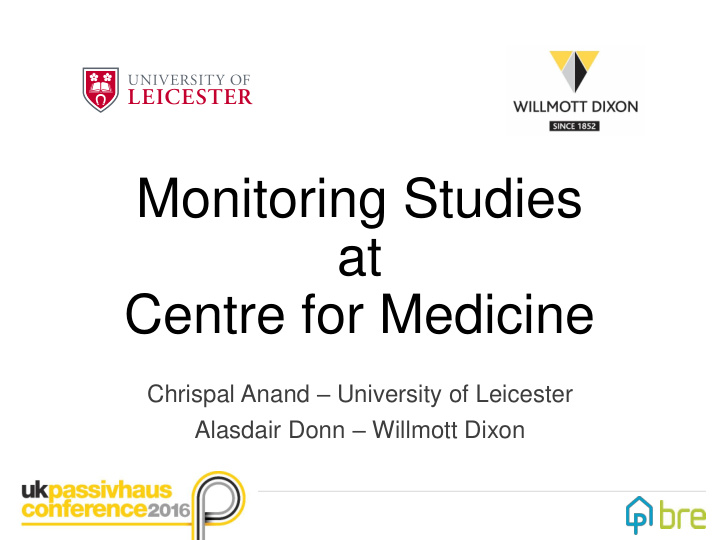



Monitoring Studies at Centre for Medicine Chrispal Anand – University of Leicester Alasdair Donn – Willmott Dixon
Content Summary Introducing the UK’s largest Passivhaus building - - Centre for Medicine - Soft Landings as a means to translate Passivhaus low carbon build to low carbon operation - Proactive monitoring of energy data - Non-energy monitoring information / user & behavioural factors - Future monitoring and management Issues
UK’s Largest Passivhaus Building Total GIA -13,526 m 2 Certified to the PassivHaus standard 15 kWh/m2 per year heating demand 120 kWh/m 2 per year total primary energy demand BREEAM ‘Excellent’ Rating Air-tightness target of 1m 3 /m 2 .hr @50Pa (0.33 ACH) Energy Performance Certificate ‘A’ DEC rating target of ‘A ‘– how the building performs in use First use of computer controlled shading system in the UK Ground to Air Heat Exchange Labyrinth under the building - 1.6km of ventilation pipework Connected to the Leicester District Heating Scheme & CHP unit within the University £42M investment by the University
Our Rationale “… to bring world-leading research and high- quality medical education under one roof for the first time.” To use this building as the major contribution to reducing the estates carbon emissions by 60%.
Our Current Building Stock Maurice Shock Building 320kWhr/m 2 per annum space heating 500kWhr/m 2 per annum total energy £360,000 per annum energy bill
Soft Landings - Translating Passivhaus/Low Carbon Build to Low Carbon Operation - Soft Landings and Passivhaus (needs to go hand-in- hand). - Involvement in Soft Landings (final stages of construction, handover and post occupancy support for 3 years). - Importance of operations and actual use of the building from a energy and carbon reduction strategy is paramount. - Building user training during handover is key. - First time where users, University FM teams and contractor working together post construction.
Soft Landings - Translating Passivhaus/Low Carbon Build to Low Carbon Operation Soft Landings issues – Post Occupancy Lighting Heating Blinds Furniture Other
Monitoring Building Performance • The building has over 90 sub-meters. • The meters record electricity, heat/cooling and water consumption data on 30 mins interval. • Each type of energy use has been benchmarked and is proactively monitored by Estates Energy Team. March 2016 Estimated Total March Estimated Energy Loads in CFM Actual Energy Energy Use (kWh) Energy Use (kWh) Use (kWh) Lighting 148,110 13,440 7,680 Lifts & Escalators 40,300 3,360 717 Small Power 195,890 19,960 4,468 Catering 41,890 4,270 3,210 Server Rooms 36,830 3,750 4,936 Domestic Hot Water 72,290 7,370 7,370 Fans 88,990 5,550 10,691 Pumps/controls/heat rejection 9,600 940 Total Cooling 58,330 3,250 1,907 Total Elec 692,200 61,900 40,979 Total Heating 112,400 10,400 13,444
17% below cumulative target usage to date
25% below cumulative target usage to date
7 month actual total – 78 MWh NGB model target – 113 MWh/yr PHPP model target – 149 MWh/yr 46% above cumulative target usage to date
Space Heating Basis MWh/yr kWh/m2.yr Usage Target NGB model 113 9.6 Target PHPP model 149 12.6 Target PHPP standard 176 15 Actual * 6m measured + 6m projected * 170 14.6 * April - Sept 2016 correlation between actual usage and heating degree days, Oct – March projected based on 2015/16 degree days. Heating controls not fully optimised in March 2016.
22% below cumulative target emissions to date 21% below cumulative target costs to date
Non-energy monitoring information / user & behavioural factors
Non-energy monitoring information / user & behavioural factors Community living • Working harmoniously • Building a community • Sharing the building with students • Sharing the building with visitors
Non-energy monitoring information / user & behavioural factors Get-togethers
Future Monitoring & Management Issues Current Building Stock Vs New Building Stock Maurice Shock Building The Centre for Medicine 15kWhr/m 2 per annum space heating 320kWhr/m 2 per annum space heating 80kWhr/m 2 per annum total energy 500kWhr/m 2 per annum total energy £360,000 per annum energy bill £57,600 per annum energy bill
Future Monitoring & Management Issues Provide monthly feedback to building users. Using automated metering alarms to pick up anomalies on data and consumption. Key ongoing challenges: On-going building user engagement Maintaining competency of how to use the building Issue the first Display Energy Certificate (DEC) during May 2017. Aim is to obtain DEC ‘A’ by May 2019.
Questions?
Recommend
More recommend